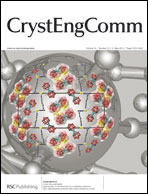Hydrothermal syntheses at 185 °C for 24 h yield the pure cubic Ia![[3 with combining macron]](https://www.rsc.org/images/entities/char_0033_0304.gif) micro- and nanosized Tm3+-doped Lu2O3 crystalline sesquioxide, with morphologies that are tailored through the crystallographic phase of the hydrothermal precursors generated by the reaction conditions. Observed morphologies have been described as porous stacked bricks, square nanosheets, bundled porous nanorods, microsized porous cubooctahedra, nanowires and non-porous tablets. The prepared 0.5 mol% Tm3+-doped Lu2O3 shows in all cases excitation (3H6 → 3H4) and emission (3H4 → 3F4 and 3F4 → 3H6) spectra of Tm3+ similar to those observed in single crystals. Room temperature luminescence decays of 3H4 exhibit non-exponential dynamics analytically reproduced by the sum of two exponential regimes, which are ascribed to the different rates of non-radiative relaxations in defects at the surface and in the body of the nanocrystals. For non-porous tablets the value of the measured long-lived 3H4 Tm3+ fluorescence lifetime τ is ∼240 μs, i.e., close to τ values measured in Lu2O3 single crystals with a similar Tm3+ doping level.
micro- and nanosized Tm3+-doped Lu2O3 crystalline sesquioxide, with morphologies that are tailored through the crystallographic phase of the hydrothermal precursors generated by the reaction conditions. Observed morphologies have been described as porous stacked bricks, square nanosheets, bundled porous nanorods, microsized porous cubooctahedra, nanowires and non-porous tablets. The prepared 0.5 mol% Tm3+-doped Lu2O3 shows in all cases excitation (3H6 → 3H4) and emission (3H4 → 3F4 and 3F4 → 3H6) spectra of Tm3+ similar to those observed in single crystals. Room temperature luminescence decays of 3H4 exhibit non-exponential dynamics analytically reproduced by the sum of two exponential regimes, which are ascribed to the different rates of non-radiative relaxations in defects at the surface and in the body of the nanocrystals. For non-porous tablets the value of the measured long-lived 3H4 Tm3+ fluorescence lifetime τ is ∼240 μs, i.e., close to τ values measured in Lu2O3 single crystals with a similar Tm3+ doping level.

You have access to this article
 Please wait while we load your content...
Something went wrong. Try again?
Please wait while we load your content...
Something went wrong. Try again?
![[3 with combining macron]](https://www.rsc.org/images/entities/char_0033_0304.gif) micro- and nanosized Tm3+-doped Lu2O3 crystalline sesquioxide, with morphologies that are tailored through the crystallographic phase of the hydrothermal precursors generated by the reaction conditions. Observed morphologies have been described as porous stacked bricks, square
micro- and nanosized Tm3+-doped Lu2O3 crystalline sesquioxide, with morphologies that are tailored through the crystallographic phase of the hydrothermal precursors generated by the reaction conditions. Observed morphologies have been described as porous stacked bricks, square 

 Please wait while we load your content...
Please wait while we load your content...